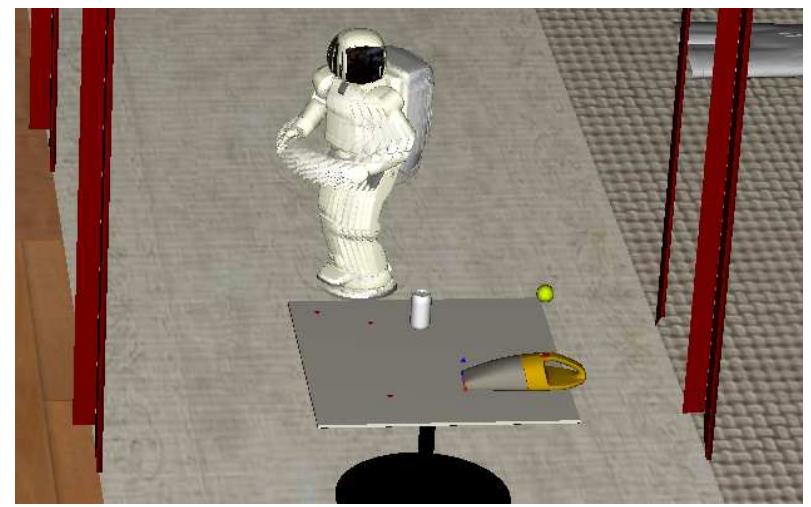Toward a vocabulary of primitive task programs for humanoid robots
International Conference on …
Abstract
Researchers and engineers have used primitive actions to facilitate programming of tasks since the days of Shakey [1]. Task-level programming , which requires the user to specify only subgoals of a task to be accomplished, depends on such a set of primitive task programs to perform these subgoals. Past research in this area has used the commands from robot programming languages as the vocabulary of primitive tasks for robotic manipulators. We propose drawing from work measurement systems to construct the vocabulary of primitive task programs. We describe one such work measurement system, present several primitive task programs for humanoid robots inspired from this system, and show how these primitive programs can be used to construct complex behaviors. Index Terms— robot programming, task-level programming, humanoid robots
References (16)
- N. J. Nilsson, "A mobile automaton: An application of artificial intelligence techniques," in Proc. of Intl. Joint Conf. on Artificial Intelligence, Washington, D.C., May 1969.
- S. Schaal, "Is imitation learning the route to humanoid robotics?" Trends in Cognitive Sciences, vol. 3, no. 6, pp. 233-242, 1999.
- E. Drumwright and M. Matarić, "Generating and recognizing free- space movements in humanoid robots," in 2003 IEEE/RSJ Intl. Conf. on Intelligent Robots and Systems (IROS), Las Vegas, NV, October 2003, pp. 1672-1678.
- T. Lozano-Pérez, "Task planning," in Robot motion: planning and control, M. Brady, J. M. Hollerbach, T. L. Johnson, T. Lozano-Perez, and M. T. Mason, Eds. MIT Press, 1982, pp. 474-498.
- R. Taylor, P. Summers, and J. Meyer, "Aml: A manufacturing lan- guage," Intl. Journal of Robotics Research, vol. 1, no. 3, 1982.
- S. Narasimhan, "Task level strategies for robots," Ph.D. dissertation, Massachusetts Institute of Technology, 1994.
- A. M. Segre, Machine learning of robot assembly plans. Kluwer Academic Publishers, 1988.
- J. R. Chen, "Constructing task-level assembly strategies in robot programming by demonstration," Intl. Journal of Robotics Research, vol. 24, no. 12, pp. 1073-1085, Dec 2005.
- D. C. Bentivegna, "Learning from observation using primitives," Ph.D. dissertation, Georgia Institute of Technology, 2004.
- A. Fod, M. Matarić, and O. Jenkins, "Automated derivation of primi- tives for movement classification," Autonomous Robots, vol. 12, no. 1, pp. 39-54, January 2002.
- A. Ijspeert, J. Nakanishi, and S. Schaal, "Learning attractor landscapes for learning motor primitives," in Advances in Neural Information Processing Systems 15, S. Becker, S. Thrun, and K. Obermayer, Eds., 2002, pp. 1547-1554.
- D. W. Karger and W. M. Hancock, Advanced Work Measurement. New York, NY: Industrial Press, Inc., 1982.
- W. Antis, J. John M. Honeycutt, and E. N. Koch, The Basic Motions of MTM. The Maynard Foundation, 1973.
- B. W. Niebel, Motion and time study, 8th ed. Richard D. Irwin, Inc., 1988.
- E. Drumwright and V. Ng-Thow-Hing, "The task matrix: An extensible framework for creating versatile humanoid robots," in Proc. of the IEEE Intl. Conf. on Robotics and Automation (ICRA), Orlando, FL, USA, 2006.
- K. Hirai, M. Hirose, Y. Haikawa, and T. Takenaka, "The development of honda humanoid robot," in Proc. of the IEEE Intl. Conf. on Robotics and Automation (ICRA), Leuven, Belgium, May 1998, pp. 1321-1326.
 Victor Ng-Thow-Hing
Victor Ng-Thow-Hing Evan Drumwright
Evan Drumwright






